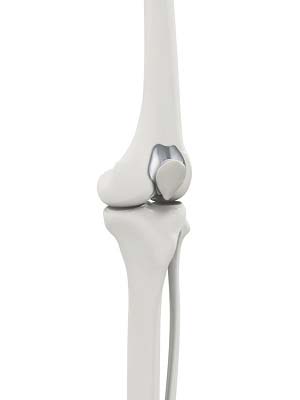Patellofemoral Knee Replacement

What is Patellofemoral Knee Replacement?
Traditionally, a patient with only one compartment of knee arthritis would undergo a total knee replacement surgery. Patellofemoral knee replacement is a minimally invasive surgical option that preserves the knee parts not damaged by arthritis as well as the stabilizing anterior and posterior cruciate ligaments, ACL and PCL.
The smaller implants used with a partial knee replacement surgery are customized to your anatomy based upon CT scans of your knee. A surgical robotic arm assists your surgeon with pre-operative planning and intraoperative component placement, positioning, and alignment. Patellofemoral knee arthroplasty surgery will not alter the ability of the patient to eventually move to a total knee replacement in the future should that become necessary.
Indications of Patellofemoral Knee Replacement
Patellofemoral knee replacement surgery may be recommended by your surgeon if you have osteoarthritis contained to the patellofemoral compartment and you have not obtained adequate relief with conservative treatment options. This less invasive bone and ligament preserving surgery is especially useful for younger, more active patients as the implant placed more closely mimics actual knee mechanics than does a total knee surgery.
Patellofemoral Knee Replacement Procedure
Partial Knee Replacement surgery is performed in an operating room under sterile conditions with the patient under general anesthesia or spinal anesthesia with sedation. It is usually performed on an outpatient basis as day surgery.
- Your surgeon makes a small incision, about 3-4 inches long over the knee.
- With the assistance of the robotic arm, the patellofemoral compartment is prepared for the artificial components by removing the damaged part of the patella and trochlea, the groove at the end of the femur.
- The new artificial components are fixed in place with the use of bone cement.
- The femoral component is made of polished metal and the patellar component looks like a plastic button which will glide smoothly in a groove located on the femoral component.
- With the new components in place, the knee is taken through a range of movements.
- Once the surgeon is satisfied with the results, the arthroscope and surgical instruments are removed and the incisions covered with a sterile dressing or biologic glue.
Postoperative Recovery after Patellofemoral Knee Replacement
Common post-operative guidelines include:
- You will be taken to the recovery room and monitored for any complications.
- You will be given pain medication to keep you comfortable at home.
- You will need someone to drive you home due to the drowsy effects of the anesthesia.
- Swelling is normal after knee surgery. Ice, compression, and elevation of the knee will be used to minimize swelling and pain.
- You will be given specific instructions regarding activity. Usually there are few activity restrictions.
- You will be referred to a rehabilitation program for exercise and strengthening.
- Eating a healthy diet and not smoking will promote healing.
Risks and Complications of Patellofemoral Knee Replacement
As with any major surgery there are potential risks involved. The decision to proceed with the surgery is made because the advantages of surgery outweigh the potential disadvantages.
It is important that you are informed of these risks before the surgery takes place.
Complications can be medical (general) or specific to knee surgery. Medical complications include those of the anesthetic and your general wellbeing. Almost any medical condition can occur so this list is not complete. Complications include:
- Allergic reactions to medications
- Blood loss requiring transfusion with its low risk of disease transmission
- Heart attacks, strokes, kidney failure, pneumonia, bladder infections
- Complications from nerve blocks such as infection or nerve damage
- Serious medical problems can lead to ongoing health concerns, prolonged hospitalization, or rarely death.
Complications are rare after knee surgery, but unexpected events can follow any operation. Your surgeon feels that you should be aware of complications that may take place so that your decision to proceed with this operation is taken with all relevant information available to you.
Specific complications related to patellofemoral knee replacement surgery include:
- Infection : Infection can occur with any operation. In the knee this can be superficial or deep. Infection rates are approximately 1%. If it occurs, it can be treated with antibiotics, but may require further surgery.
- Deep vein thrombosis : DVT are blood clots that can form in the calf muscles and travel to the lung (pulmonary embolism). These can occasionally be serious and even life- threatening. If you get calf pain or shortness of breath at any stage, you should notify your surgeon.
- Ligament injuries: There are several ligaments surrounding the knee. These ligaments can be torn during surgery or break or stretch out any time afterwards. Surgery may be required to correct this problem.
- Injury to blood vessels or nerves: Rare, but can lead to weakness and loss of sensation in part of the leg. Damage to blood vessels may require further surgery if bleeding is ongoing.
- Arthrofibrosis: This is the development of thick, fibrous material around the joint that often occurs after joint injury or surgery and can lead to joint stiffness and decreased movement.
- Wearing out: The components eventually wear out over time, usually 10 to 15 years, and may need to be changed.
- Dislocation: An extremely rare condition where the ends of the knee joint lose contact with each other.
- Fractures or breaks: Can occur during surgery or afterwards if you fall. To fix these, you may require surgery.
Risk factors that can negatively affect adequate healing after knee arthroscopy include:
- Poor nutrition
- Smoking
- Obesity
- Age (over 60)
- Alcoholism
- Chronic Illness
- Steroid Use

